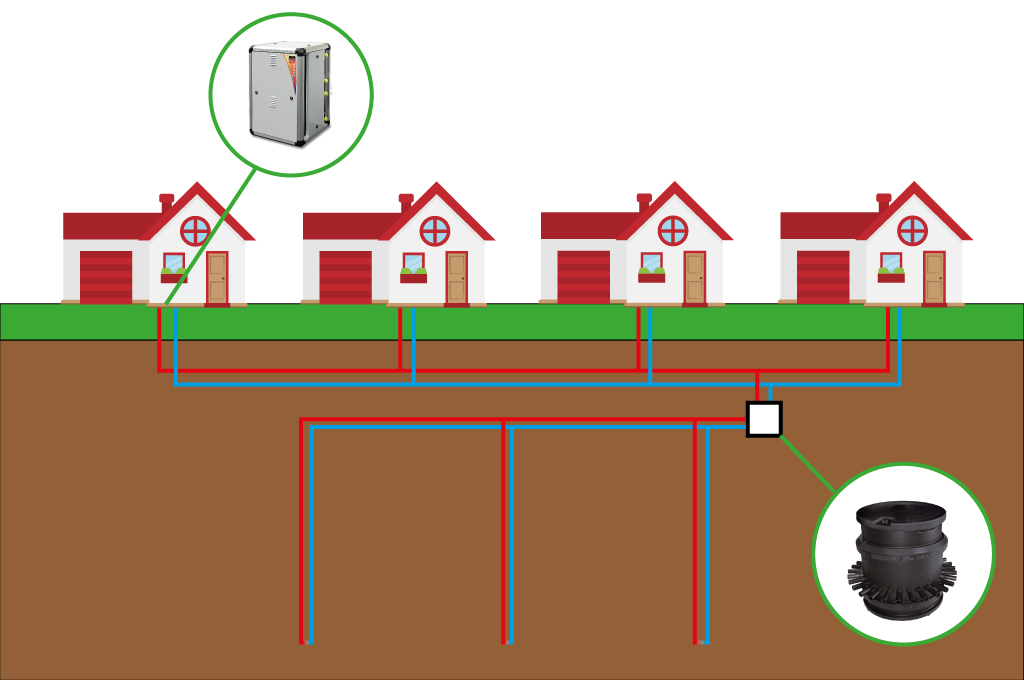SHARED GROUND LOOP ARRAYS
WHAT IS A SHARED GROUND LOOP?
A “shared ground loop” is the name given to a district heating network where at least two or more properties have an individual heat pump connected to a communal ground loop.
The shared ground loop is installed as a series of boreholes, central to either a community of houses or serving one large building of multiple dwellings.
Similar to a standard ground source heat pump system, the ground loop runs on a continuous cycle through the ground, absorbing thermal energy. The ground loop then provides this thermal energy (typically between temperatures of 5oC and 12oC) to individual heat pumps connected to the shared ground loop system. Each heat pump is then responsible for raising the heat to a temperature that’s suitable to be used in the property’s central heating system.

DIFFERENCE BETWEEN SHARED GROUND LOOPS AND HEAT NETWORKS
A shared ground loop is similar to a district heat network in that both use one communal ground loop to gather thermal energy from the ground. Where they differ is that a shared ground loop allows multiple individual heat pumps to be served by one ground loop, while in a district heating network, the ground loop serves one or two large heat pumps which supply the heat for all properties in the network.
ADVANTAGES OF A SHARED GROUND LOOP
- Independence: Occupants have an individual heat pump, powered by their own electrical supply. Individual billing gives people clarity over their bills and control over their spending, while having the ability to adjust the system to personal preferences.
- Cost Savings: The cost of installing a shared ground loop is typically less than for an individual ground source heat pump systems. Less boreholes are needed to serve the shared loop system and mobilisation costs are kept to a minimum.
- Versatility: Shared ground loops are suited to any building, whether it be new builds or retrofits. The loop can be expanded at any time in the future to expand the network. The boreholes of the system can be distributed flexibly across the site, ensuring that the ground doesn’t get exhausted.
- Resilience: Should a fault with an individual heat pump occur anywhere on the shared ground loop network, it will not affect any other heat pump connected to the system. Each heat pump is entirely independent of one another, so should a heat pump go down or need maintenance, no other heat pump is affected.
Funding for shared ground loops
The Green Heat Network Fund (GHNF) is a £270 million government fund designed to 'Incentivise the heat network market transition to low carbon heat sources via targeted financial support, that will help stimulate the increased deployment of low carbon technologies at scale.' The GHNF has been developed by BEIS. There are some instances where shared ground loops can qualify for the funding - this depends on the energy demand of the project with the threshold being 2GWh/year. If you're working on a project that will deliver this energy demand, you may want to consider making an application.
For projects that do not meet this threshold, there are new funding initiatives also being developed to replace the Renewable Heat Incentive - the Clean Heat Grant is one of these and it may provide funding for shared ground loops which do not meet the 2GWh/year threshold for the GHNF.
Benefits of A Shared Ground Loop to Occupants
Green, emissions-free energy: Occupants switch to a form of heating with a dramatically reduced environmental impact, with zero sacrifice to comfort.
Lower bills: Bill payers will realise significantly lower bills as part of a shared ground loop system. While electricity usage does increase, a heat pump creates an average output of 3-4kWh of heat for every 1kWH of electricity input. This makes heat pumps more efficient than traditional fossil fuel heating methods.
Heating and cooling option: During the summer months heat pumps can work in reverse to provide a cooling. Excess heat generated during warmer weather can be recovered and used to re-charge the ground.
Low Maintenance: Heat pumps are very low maintenance, requiring little more than an annual service. If well maintained, heat pumps have an average lifespan of between 20-30 years.
MasterTherm AQ17I: Designed for Shared Ground Loops

MasterTherm, an industry leader in heat pump technology and a manufacturer of which Thermal Earth is the exclusive UK distributor, has recognised the growing emergence of shared ground loops and has developed a heat pump to suit.
The AQ17I is the most advanced compact ground source heat pump in the UK, designed to fit inside a kitchen unit or utility room without dominating the space. Its low output range of 1kW to 5kW is perfectly suited to provide comfortable heating in well-insulated new build properties or apartments.
 Facebook
Facebook LinkedIn
LinkedIn Twitter
Twitter
















